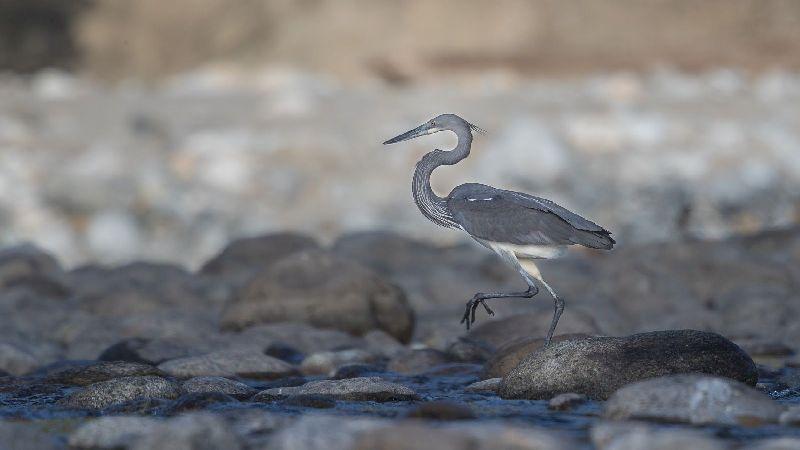
Image credits: Sagar Gosavi
Did you know that the White-bellied Heron (Ardea insignis) is the world’s second-largest heron? This magnificent bird is found in parts of north-east India, Bhutan, north-west Myanmar and China. The riverine bird features on the IUCN’s Red List as Critically Endangered, likely due to human activities such as overfishing, mining, dam construction and habitat destruction.
Conservation programmes targeting these birds need to know how many of them are left in the wild. In a first-ever attempt, Rohan Menzies, Megha Rao, and Rohit Naniwadekar from the Nature Conservation Foundation (NCF), Bengaluru, surveyed White-bellied Herons across the Indian Eastern Himalayas. It was funded by the Wildlife Conservation Trust, Ravi Sankaran Foundation, and the Rufford Small Grants for Nature Conservation, and was published in the journal Bird Conservation International.
The researchers surveyed 81 study sites across Arunachal Pradesh and the Manas National Park in Assam. In India, most of the information we have about these herons come from the Namdapha Tiger Reserve in Arunachal Pradesh. This state was thought to have over a third of the bird’s global range as it has many river drainages that are ideal habitats for these birds.
Through the survey, the researchers aimed to identify areas in which White-bellied Herons were present and compare them to regions where the birds were absent. The treacherous terrain of the northeast, with its ravines and slopes, posed a challenge for the survey. Despite this, they carried on their study between October 2017 and April 2018 in Arunachal Pradesh, and in January 2019 in Assam.
“We need to generate interest in the bird, not just amongst the general public for its conservation, but also within the scientific community,” says Megha, on the need for such surveys.
The researchers surveyed eighty-one sites across 23 unique localities that covered 101.3 km along a river, inside and outside of protected areas to identify potential sites for the heron. For each site, they marked any sightings of the bird. They also noted the elevation of the site, the width of the river and its water current, whether the river bank was rocky or sandy, and whether there were any human activities such as bouldering, mining, fishing or littering. They sought the help of the local communities, who are familiar with the terrain, to gather additional information on the rare heron. “The local community members frequent the river and have a good understanding of the biodiversity of the region and their knowledge can be invaluable to determine the presence of endangered species like the heron”, says Rohit.
Among the surveyed sites, the researchers spotted the White-bellied Herons on six occasions, all inside Namdapha Tiger Reserve. At five of these sightings, the birds were solitary, and on one, there was a pair. No birds were seen in any other surveyed areas in the entire of Arunachal Pradesh or Assam. When the researchers asked the local communities about the presence of these birds, most were not able to identify the bird indicating the absence of the bird in their areas. The few who could, revealed that the birds were scarce. According to the field and interview surveys, in the last year, the bird was reported in only two of the 23 localities that were surveyed—in the Namdapha Tiger Reserve and D’Ering Wildlife Sanctuary on the Assam–Arunachal Pradesh border.
Why were the herons seen only in the Namdapha Tiger Reserve, which was a protected area? “It is still not completely understood why the heron is found only here and is so rare in other seemingly similar habitats outside the Reserve. The reasons can be many, one of which could be relatively low or no hunting pressures on the bird inside Namdapha. Another could be that the rivers in the reserve still harbor large fish which are important for this species. We do not know the status of the fishes in other rivers. However, we documented destructive fishing techniques, like the use of explosives, electric shocks and poison, which can quickly and negatively affect fish populations with potential cascading impacts for the heron which is dependent on fishes,” says Rohit. Further studies that compare similar river stretches with and without the heron are needed to understand the precise reasons for its absence or rarity outside Namdapha Tiger Reserve.
The researchers say that garbage and mining activities along the rivers here were significantly lesser when compared to non-protected areas. Besides, the elevation of sites in Namdapha was also lower than those in other regions. However, it is not to say these birds prefer lower elevations. “In Bhutan, the White-bellied Heron has been recorded at relatively high elevations. It is difficult to say what the situation is in India because we have very little data. We only saw the bird at Namdapha during our survey,” says Rohan.
“As far as the behaviour and the distribution of the species in India are concerned, the heron seems to be prominently absent from places that see human footfall. Interestingly, in Namdapha, these herons continue to survive and live alongside a tribal community,” shares Megha.
The heron is on the brink of extinction at least in the Indian part of the Eastern Himalaya. They occur in low densities and their populations are small. Random events like even the natural death of an adult bird due to injury, disease and/or predation can have drastic consequences for the persistence of the population.
Although the lack of access to some survey sites in the study may have resulted in fewer sightings, it is evident that human activities are likely to have drastic consequences for the bird. The proposed dams will change the nature of free-flowing rivers forever in the near future. This will mean if the populations do recover, the habitat that remains will be small or fragmented in nature. Apart from additional studies to understand its ecology, immediate conservation actions need to be taken to ensure the persistence of the species in places like Namdapha, which can at least act as a source population for the adjoining areas.
The researchers suggest a long-term monitoring program in India to identify the threats to their existence. “We are currently in talks to plan a focused study on the White-bellied Herons in Namdapha to understand the ecology better to identify the conservation needs of this species,” signs off Rohit. Further, since the bird was seen only in Namdapha and not anywhere else, the team feels that more research is needed to understand exactly why this happens.






